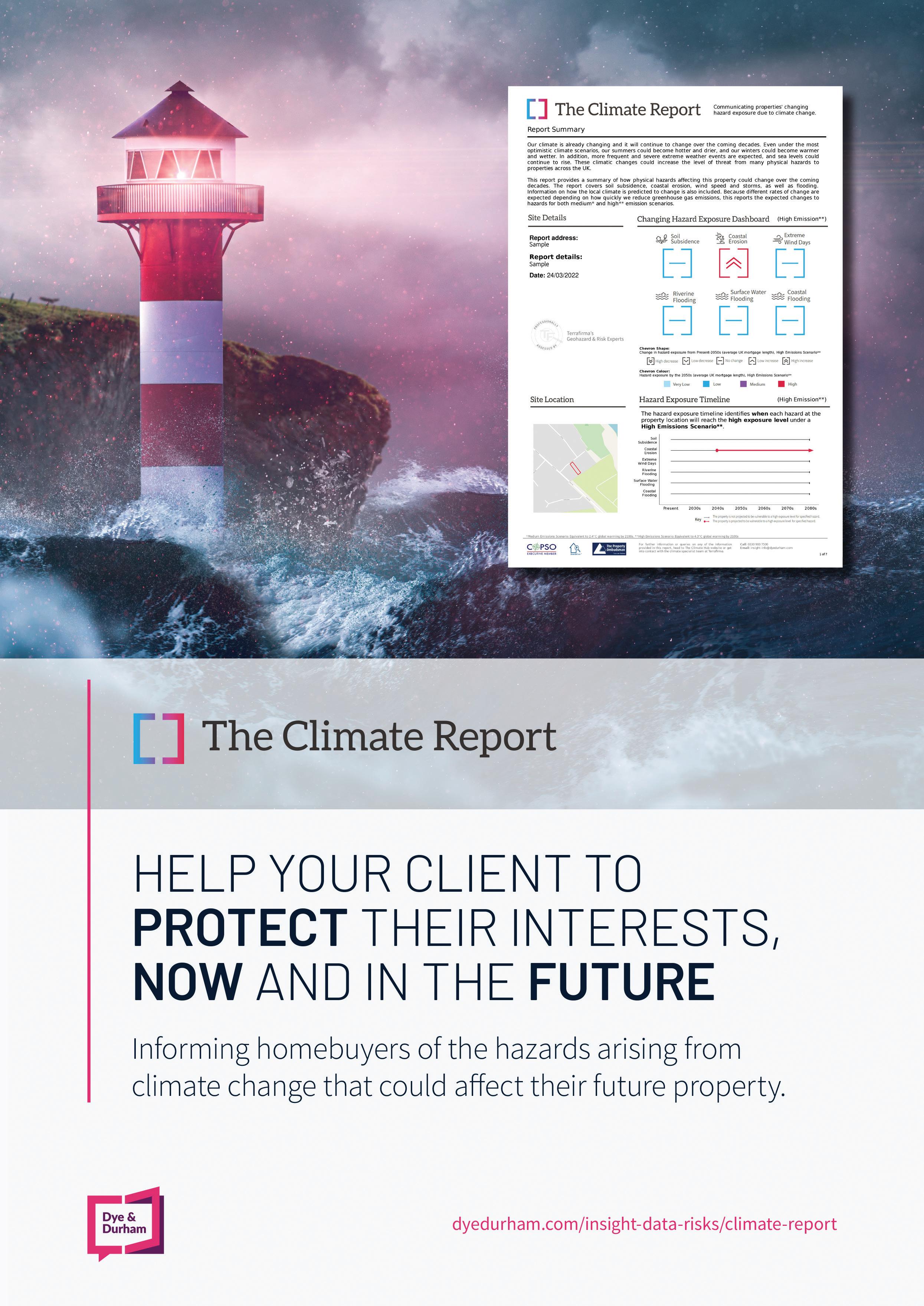
4 minute read
Ground Hazards and Due Diligence
Ground Hazards: Due Diligence for Today
and the Future By Dr. Tim Farewell, Head of Science, Dye & Durham
To ensure that home
buyers have a clear understanding of possible hazards or restrictions that have the potential to affect their future home, a diligent property professional will always recommend undertaking a variety of searches for every residential transaction.
A contaminated land or flood search are often routinely undertaken by many, regardless of location, property type, size, proposed use or client.
Yet, other well-known environmental issues such as subsidence, which has the potential to create a problem with lending and insurability if identified, are not always a go-to search. While this hazard may not be an issue everywhere in the UK today, we do believe it is an issue that should be taken seriously, particularly as we look into the future.
We know that subsidence can be caused by a number of issues, including the shrinkage and swelling of soils in response to changing moisture conditions, the impact of trees, aging infrastructure or man-made disturbances. To date, subsidence searches have looked at historic data to understand if such risks pose a threat to a property address, however with the changing climate, we believe it is vital to instead look forward to model future hazards.
We have undertaken some analysis of our National Ground Risk Model (NGRM): Climate™, which models future climaterelated environmental hazards, and identified that more than 7.65 million properties in Great Britain could be exposed to medium or high risk of soil subsidence by the 2080s. This is an increase of over 1.89 million individual properties, and is as a result of climate change1 .
With all climate models projecting hotter, drier summers in the future, there is increasing likelihood of soil shrinkage, which can create downward movement in buildings located on vulnerable soils. This shrinkage is worse in clay soils, which are commonly found across the south east of England, and has the potential to move foundations, cracking walls and ceilings, resulting in expensive insurance claims and repair bills.
Modelling Future Hazards for Homebuyers Our data suggests that more than 5.76 million properties in Great Britain are today exposed to medium or high subsidence risk. This increases to approximately 6.64 million in the 2030s. Specifically, just over half a million more properties (547,317) could be at high exposure in the next 60 years, compared to today’s figures.
Looking at Hertfordshire, our data shows that 22.5% of the county’s area will see soil subsidence hazard risk increase from moderate to high by the 2050s, with a further 9% moving to ‘very high’.
In fact by the 2050s, our data shows us that over 80 counties across the UK are likely to experience an increased risk of soil subsidence hazard to some degree, moving from low to moderate, moderate to high, or high to very high, as a result of our changing climate. In particular, additional parts of Middlesex, Hampshire, Berkshire, Hertfordshire and Surrey could move to the highest subsidence hazard classes by the 2050s2 .
Future Insights from the Climate Report Last October, the Law Society published a Climate Change Resolution3 that outlined the role solicitors can play in addressing the climate crisis, which included a call to action to develop a climate-conscious approach to legal practice.
But what does this mean for property lawyers and conveyancers? We believe there is the potential to help clients understand climate change impacts by providing data insights as part of the conveyancing due diligence process.
Dye & Durham’s market leading Climate Report launched to help property lawyers and conveyancers protect homebuyers’ best interests and make informed, futurefacing decisions.
In addition to subsidence, the Climate Report models a range of hazards for individual properties, including coastal erosion, flood risk exposure and extreme winds, over the next 60 years.
The report has been designed to cover both physical hazards and delve into how extreme climate conditions could affect properties over time.
Ultimately, robust climate science indicates that we will see more hotter, drier summers and wetter winters as a result of our changing climate. These conditions are of real concern as they are likely to result in an increase in both the severity and frequency of climate-related impacts to our homes, infrastructure and, more worryingly, the health of vulnerable members of our communities.
In conveyancing, there is a tendency to look backwards to determine risk levels, however it is time to start using insight and data to look forward:
If we, as an industry, can increase awareness of climate change and its potential impact on our homes and communities, more people will become engaged and want understand how this may affect their property in the future and take steps to help mitigate risks posed by the changing climate.
If you would like to discuss this topic with me directly, you can connect via LinkedIn: www.linkedin.com/in/timothyfarewell-26557116/
To learn more about the Climate Report or to obtain a free sample, email Insightsales@dyedurham.com or visit https://
dyedurham.com/insight-data-risks/.
References:
1. Climate change data has been calculated for Unique Property Reference Numbers (UPRNs) in Great Britain, based on a Medium Emissions Scenario (RCP:4.5 Equivalent to 2.4°C global warming by 2100s)
2. Climate change data has been calculated based on a High Emission Scenario (RCP 8.5, Equivalent to 4.3°C global warming by 2100s)
3. https://www.lawsociety.org.uk/topics/ climate-change/creating-a-climate-consciousapproach-to-legal-practice










